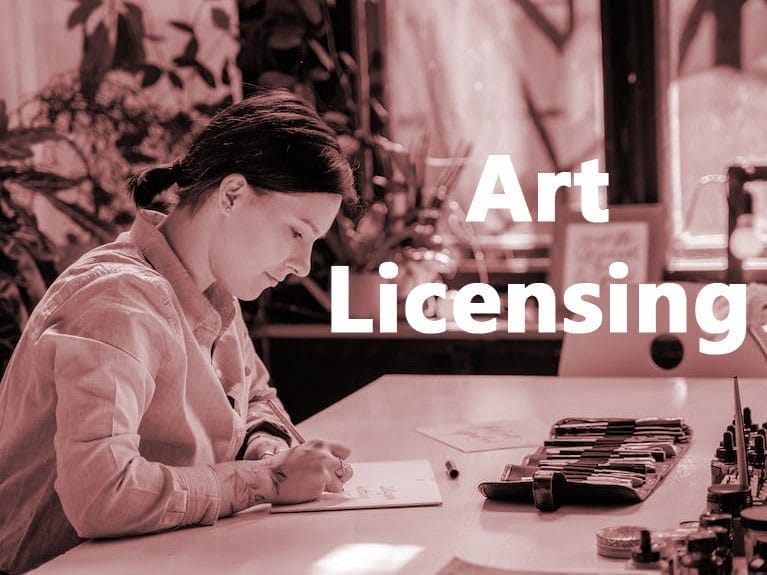As an artist, having an online business can be a total game-changer. You can reach a global audience, sell your art 24/7, and work from anywhere. No more relying on local galleries or art fairs to showcase your work – you’re in control!

With an online business, you can monetize your skills and talents in multiple ways, from selling prints to offering commissioned pieces, teaching online classes, and even licensing your art for commercial use.
An online art business also means connecting with fans and collectors worldwide, getting feedback on your work, and building a community of like-minded artists. It’s a win-win!
In this article, we’ll explore 6 online business ideas for artists you can start today to take your art to the next level.
- 1. Sell Art Prints and Products Through Online Marketplaces
- 2. Share Your Artistic Talents: Create and Sell Online Courses
- 3. Offer Commissioned Artwork and Custom Illustration Services
- 4. Building a membership or subscription-based website for exclusive content
- 5. Create and Sell Stock Illustrations and Graphics
- 6. Online Coaching or Mentoring: Guide Others to Artistic Success
DISCOVER MORE: 7 Community Engagement Ideas for Artists
1. Sell Art Prints and Products Through Online Marketplaces
Selling art prints and products on online marketplaces like Redbubble, Society6, Zazzle, and CafePress is a fantastic way to share your talent with the world and earn a steady income. With the global online art market projected to reach $1.4 billion by 2025, this business idea has significant potential.

Low Overhead, High Rewards
One of the most significant advantages of online selling art prints and related products is the low overhead cost. You don’t need to invest in inventory or storage space, as the marketplace handles production and shipping.
This means you can focus on creating new art and marketing your products without worrying about the logistics. With the right marketing strategies, you can earn passive income through print-on-demand products, build a brand, and establish yourself as an artist.
Understanding Marketplace Fees
When choosing an online marketplace to sell art, understanding each platform’s fee structures and offerings is important.
| Platform | Pricing Control | Fee Structure | Product Range |
|---|---|---|---|
| Society6 | Limited (fixed royalty) | Subscription plans with fees; Society6 sets prices | Wide variety including art prints, home decor, and apparel |
| Redbubble | Artists set their own markups | Takes a base price for production and shipping; no fixed commission | Wide range, including clothing, stickers, and home decor |
| CafePress | Customizable markups | Reduced marketplace sales commissions; strict content policies | Wide range, including clothing and accessories |
| Zazzle | Zazzle sets the base price; artists adjust the profit | Artists set their profit margins | Artists set their markups |
How to Choose
- Pricing and Control: Consider how much control you want over pricing. Redbubble and Zazzle allow artists to set their markups, while Society6 has a fixed royalty system.
- Product Range: Evaluate the types of products you want to offer. All platforms provide a wide range, but specific offerings may vary.
- Content and Policies: Review each platform’s terms of service, especially regarding AI-generated art and content restrictions. CafePress’s policy on AI training might be a concern for some artists.
- Marketing and Visibility: Consider how much effort you will put into promoting your work. Each platform has different levels of competition and audience engagement.
Each platform has strengths, and the choice should align with the artist’s business strategy and target audience.
Marketing and Promotion
To succeed in the competitive online art market, you need effective marketing and promotion strategies. These include showcasing your art on social media, engaging with your audience, and using eye-catching visuals to attract potential buyers. You can also leverage email marketing, influencer partnerships, and paid advertising to reach a wider audience.
Puzzles: A New Dimension in Art Sales
Custom-printed puzzles are a unique and engaging way to monetize your art. By partnering with a puzzle manufacturer like PuzzlesUnlimited.com, you can launch your own Jigsaw Puzzles featuring your art. Puzzles are an excellent way to appeal to art lovers who enjoy interactive experiences and want to engage with your art in a more hands-on way.
2. Share Your Artistic Talents: Create and Sell Online Courses

Creating online courses to teach art techniques is a fantastic way to connect with fellow artists and learners while generating revenue. This business idea has significant potential, with the online learning market projected to reach $325 billion by 2025.
By creating online courses, you can reach a global audience and sell your courses 24/7. This means you can earn passive income while your students learn at their own pace. You’ll also establish yourself as an expert in your artistic field, building a community of like-minded artists and learners.
Initial Investment and Ongoing Costs
You must invest time and money in creating high-quality courses to get started. Depending on production quality and course length, this can range from $1,000 to $5,000. Additionally, you’ll need to budget for marketing, which can cost between $500 to $2,000, depending on your strategies. You’ll also need to consider website or platform fees ranging from $100 to $500.
Revenue Potential
The revenue potential for online courses is substantial. Depending on your pricing, marketing, and audience engagement, you can earn between $5,000 and $50,000 or more from course sales. You can also explore affiliate marketing and sponsored content for additional income.
Choosing the Right Platform
Consider the fees and features when selecting a platform to host your courses.
| Platform | Fee Structure | Features |
|---|---|---|
| Udemy | 50% commission on sales | Large audience, easy course creation |
| Teachable | 5% commission on sales + payment processing fees | Customizable branding, affiliate marketing |
| Skillshare | Flat rate per hour of content | Large audience, focus on creative skills |
| Kajabi | Monthly subscription fees | Comprehensive platform for course creation and marketing |
Getting Started
Plan your course content and structure to turn your passion into a profitable venture. Invest in high-quality equipment and software for course production, and choose a platform or website to host your courses.
Develop a marketing strategy to reach your target audience and launch and promote your courses, engaging with students and gathering feedback. With dedication and creativity, you can build a successful online course business.
3. Offer Commissioned Artwork and Custom Illustration Services

As an artist, there’s no greater joy than bringing a client’s vision to life. Offering commissioned artwork and custom illustration services is a fantastic way to connect with clients, create unique pieces, and earn a steady income.
Build Strong Relationships
To succeed, focus on developing robust client communication strategies. Listen carefully to their ideas, ask questions, and clarify expectations to ensure everyone is on the same page. This will help you deliver pieces that exceed their expectations and build a loyal client base.
Portfolio Power
A strong portfolio is your best friend when offering commissioned artwork and custom illustration services. Showcase a variety of your best pieces to attract potential clients. Consider creating a dedicated section on your website for commissioned works, highlighting testimonials and the stories behind the artworks.
Business Potential:
| Average Commission Price | Monthly Sales | Monthly Revenue |
|---|---|---|
| $200 – $1,000 per piece | 5 – 10 commissions | $1,000 – $10,000 |
Offering commissioned artwork and custom illustration services provides flexibility to work on unique projects and connect with clients directly. However, it can be time-consuming, and creative client differences may arise.
Tips for Success:
- Develop a clear contract and payment terms
- Focus on client satisfaction and feedback
Commissioned Artwork Pricing Guide:
Pricing your artwork effectively is crucial. Research what other artists charge for similar work, and consider your experience, time, and skills. Don’t undervalue your talents; set prices that reflect your worthwhile remaining reasonable for clients.
| Type of Artwork | Average Price Range |
|---|---|
| Digital illustration | $100 – $500 |
| Watercolor painting | $200 – $1,000 |
| Oil painting | $500 – $2,500 |
| Custom portrait | $300 – $1,500 |
By combining effective communication, innovative pricing, and a strong portfolio, you can successfully grow your commissioned artwork business and meet your clients’ needs.
DISCOVER MORE: What Are Art Commissions and How to Get Them
4. Building a membership or subscription-based website for exclusive content
Building a membership or subscription-based website offers a unique way to engage with your fans, provide exclusive content, and earn a steady income. With the global online subscription market projected to reach $150 billion by 2025, this business idea has significant potential.
The Digital Classroom – The demand for semi-personalized or group-based tuition in art skills, tips, and techniques is rising as more individuals seek to explore their creative potential and improve their artistic abilities.
With the proliferation of social media platforms, online tutorials, and art communities, people are increasingly inspired to learn and share their art. However, many find one-on-one lessons too expensive or intimidating, while online tutorials lack the interactive feedback and support they crave.

Group-based tuition fills this gap, offering a collaborative and social learning environment where students can learn from experienced artists, receive feedback, and connect with like-minded individuals. This format particularly appeals to beginners, hobbyists, and those seeking to refresh their skills, as it provides a supportive and motivating atmosphere to explore various art forms, styles, and techniques.
Create a Community
Imagine a space where you can share behind-the-scenes content, tutorials, and personalized art experiences with your most loyal fans. A membership website allows you to build a community around your art, fostering a deeper connection with your audience.
By offering semi-personalized or group-based tuition, artists can capitalize on this growing demand, share their expertise, and build a loyal community of students passionate about art.
Engage and Retain Subscribers
To keep your members excited and engaged, try these techniques:
- Regular Live Q&A Sessions: Connect directly with your members, answering their questions and discussing your art process.
- Exclusive Downloadable Content: Offer high-quality digital art, wallpapers, or tutorials available only to subscribers.
Business Potential:
When setting up your site, consider different subscription pricing models. Tiered levels can cater to varying budgets while maximizing your income potential.
- Average monthly subscription price: $10 – $50 per member
- Monthly revenue: $1,000 – $10,000 (with 100 – 1,000 subscribers)
- Growth potential: 10% – 20% per year (with effective content creation and engagement strategies)
Membership Website Pros and Cons
| Advantages | Disadvantages |
|---|---|
| Predictable income stream | Ongoing content creation requirements |
| Opportunity to build a loyal community | Need for regular engagement and updates |
| Ability to share exclusive content and experiences | Technical setup and maintenance costs |
Membership Pricing Guide:
| Tier | Price | Benefits |
|---|---|---|
| Basic | $10/month | Exclusive content, early updates |
| Premium | $25/month | Live Q&A sessions, personalized feedback |
| VIP | $50/month | Private lessons, personalized art pieces |
By building a membership website, you can create a thriving community where your art flourishes and your loyal fans feel valued. With effective content creation and engagement strategies, you can turn this idea into a successful online business.
5. Create and Sell Stock Illustrations and Graphics

Creating and selling stock illustrations and graphics online is a fantastic way to monetize your art, reach a global audience, and earn a steady income. With more people creating content and needing unique images, the demand for illustrations and graphics is increasing.
By selling your art online, you can reach a global audience, earn a steady income, and share your creativity with the world.
How It Works
- Build a Portfolio: Create a diverse collection of high-quality images, illustrations, vectors, and graphics.
- Upload to Stock Platforms: Choose platforms like Shutterstock, Adobe Stock, or iStock, and follow their submission guidelines.
- Earn Royalties: Receive a royalty every time someone purchases a license to use your artwork.
Benefits
- Passive Income: Generate income repeatedly without additional effort.
- Global Reach: Millions of users worldwide can discover and purchase your artwork.
- Flexibility: Create and upload artwork on your schedule.
Business Potential:
- Average royalty per sale: $0.25 – $2.50
- Monthly sales: 100 – 1,000 licenses (depending on portfolio size and quality)
- Monthly revenue: $25 – $2,500
- Growth potential: 10% – 20% per year (with a diverse portfolio and effective optimization)
Advantages and Disadvantages
| Advantages | Disadvantages |
|---|---|
| Passive income | Ongoing portfolio maintenance required |
| Global reach | Competition from other artists |
| Flexibility | Technical setup and upload time |
Tips for Success
- Research market trends to understand what buyers are looking for.
- Optimize keywords and descriptions for better visibility.
- Diversify your portfolio to appeal to a broader audience.
Creating and selling stock illustrations and graphics allows you to tap into a steady income stream, share your art with a global market, and build a successful online business.
6. Online Coaching or Mentoring: Guide Others to Artistic Success

As an experienced artist, you can share your knowledge and skills with others by offering online coaching or mentoring services. This is a great way to earn a steady income, help aspiring artists, and build your reputation as an expert.
How it Works
- Identify your niche: Focus on a specific art style, medium, or skill level to attract clients seeking specialized guidance.
- Develop a coaching or mentoring program: Create a structured course or one-on-one session plan to help clients achieve their artistic goals.
- Set your rates: Determine your pricing based on your experience, the program’s duration, and the level of personalized attention.
Business Potential:
- Average session price: $50 – $200 per hour
- Monthly sessions: 10 – 20 clients (depending on your marketing and reputation)
- Monthly revenue: $500 – $4,000
- Growth potential: 10% – 20% per year (with effective marketing and client referrals)
Advantages and Disadvantages
| Advantages | Disadvantages |
|---|---|
| Flexible scheduling | Time-consuming session preparation |
| Personalized attention for clients | Emotional investment in client success |
| Opportunity to build a loyal client base | Continuous marketing and promotion required |
Tips for Success
- Establish clear communication channels and expectations with clients.
- Continuously update your skills and knowledge to provide the best guidance.
- Encourage client feedback to refine your coaching or mentoring approach.
You can positively impact others’ artistic journeys by offering online coaching or mentoring services while building a rewarding and profitable business.
Get Started Online…
In today’s digital age, having an online art business opens up incredible opportunities for artists. You can showcase your talent to a global audience, earn income in various ways, and build meaningful connections with fans and fellow creators.
DISCOVER MORE: Best Places to Sell Art Online
The possibilities are endless, whether you sell prints, teach online courses, or offer personalized coaching. By embracing the online world, you can take control of your artistic journey, reach new heights, and share your creativity with people around the globe. So, why wait? Choose one or more of these 6 online ideas for Artists and start your online art business today.






